Ahead of their European Champions Cup decider against Racing 92, we examine seven areas that have set Saracens apart this season.
Mark McCall and his men still readily bring up 2014, when they lost two finals in the space of seven excruciating days.
First, on May 24, Toulon outclassed them to win 23-6 in Cardiff. Saracens were undone by moments of sheer brilliance from try-scoring megastars Matt Giteau and Juan Smith. Steffon Armitage suffocated the breakdown. Meanwhile, metronomic Jonny Wilkinson twisted the knife. He kicked 13 points.
A week later, Northampton Saints snatched an extra-time epic on the very last play. Red-blooded willpower eked out victory at Twickenham, Alex Waller shunting over to seal domestic glory.
This season, Saracens have been pretty irresistible. As McCall pointed out following a 43-19 thrashing of Worcester, reaching 80 Premiership points in a campaign disrupted by the World Cup is a special effort. Bar one disjointed half in the quarter-final – Saints the opponents once more – European performances have possibly been even more impressive.
But all 25 triumphs count for little unless silverware materialises. Saturday in Lyon represents their first chance as Racing 92 stand in the way of Champions Cup glory. Here is a look at how Saracens have developed and the template they will take into a defining occasion.
Aiming their bullets
It is one thing to load a squad with big runners. Giving them the best chance of causing havoc is entirely different. From a lineout on the Wasps 22 during last month’s Champoins Cup semi-final, Billy Vunipola was deployed in a very effective manner.
As Schalk Brits prepares to throw, the number eight stand at the front. Although Michael Rhodes, George Kruis and Maro Itoje are more likely targets further back, Vunipola is flanked by brother Mako and Petrus du Plessis. This makes him seem like a viable option.
Meanhile, look at how Wasps are set up. Flanker George Smith is defending the five-metre channel. Hooker Carlo Festuccia stands at the back of the lineout with scrum-half Dan Robson further back:
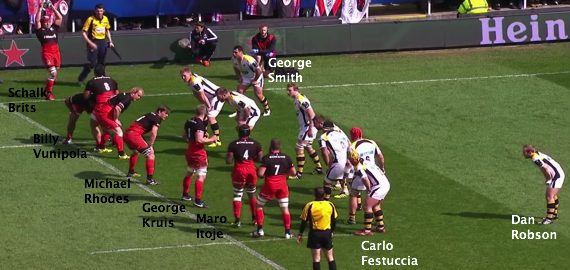
As Brits throws in, finding Itoje, Saracens execute a clearly pre-prepared plan. Expecting a maul, Festuccia is sucked towards the lifting pod. Billy Vunipola circles around from the front…
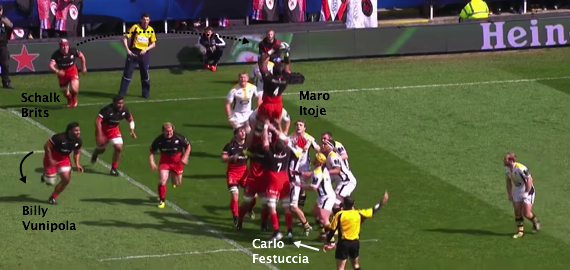
…on the way back down, delaying just slightly to sell the possibility of a driving maul, Itoje passes to his England colleague:
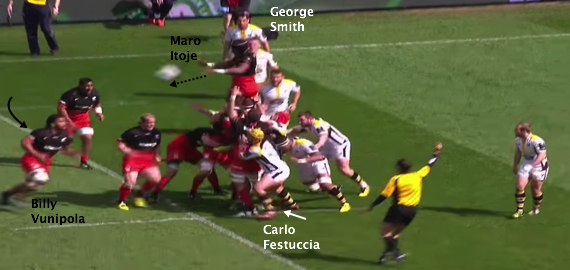
Festuccia, set too narrow to intercept Vunipola’s arc, can only flap his left arm:
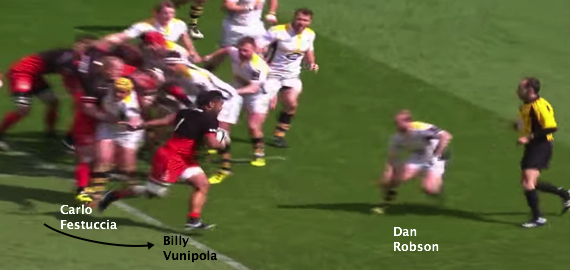
Unsurprisingly, Vunipola, supported by wing Chris Wyles and centre Brad Barritt, powers past this and through the challenge of Robson – close to 30 kilograms lighter than him:
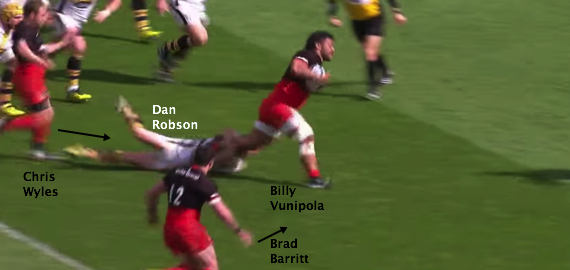
Frank Halai does stop the carry, but not before Vunipola has charged to within striking distance:
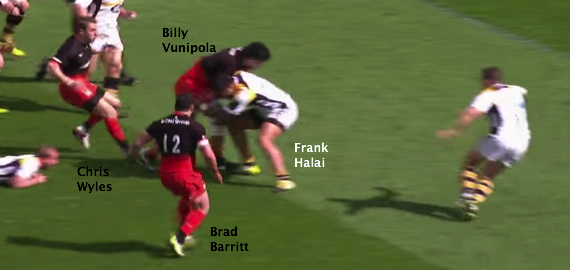
Vunipola’s ball presentation is flawless. Wyles and Barritt resource the ruck, allowing the forwards to arrive ahead of scrum-half Richard Wigglesworth and conduct a series of punchy carries close to the breakdown:
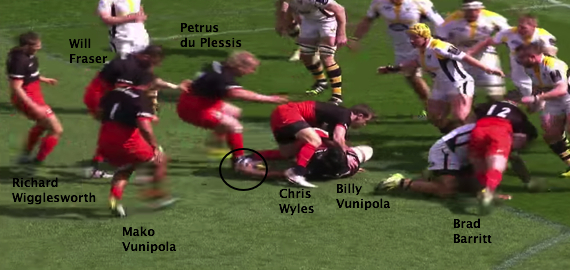
This play undoubtedly leans on brawn, but there is also acumen in manufacturing a weak point and attacking it. From a Wasps lineout in the same game, we can appreciate similarly systematic tenacity from a defensive stance.
Creating and commanding a cul-de-sac
Line-speed, hunting carriers and winning collisions – these are facets that require a good dose of primal aggression. However, the principles laid out by Paul Gustard and rammed home by Alex Sanderson have also bred a cohesive framework.
First, as Festuccia prepares to throw, note that Saracens are set up differently to the way Wasps are in the above sequence. Wigglesworth is in the five-metre channel with openside Will Fraser ready to sprint into the backline from the tail.
Before anything else, Itoje, gesturing towards Nathan Hughes, wants to disrupt the set-piece:
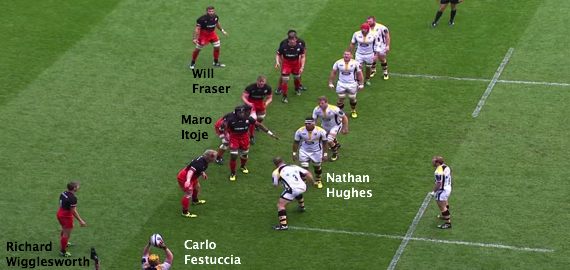
A trademark spring means he nearly does so…
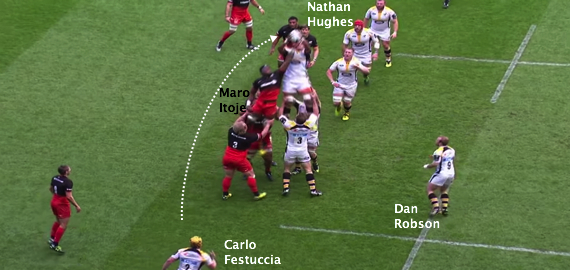
…but Hughes and Robson combine to send the ball into midfield. This sets Saracens in motion as they charge forward to crowd Siale Piutau:

Two crucial figures here are Owen Farrell and Barritt. Their work on the outside encourages Piutau to step back inside…
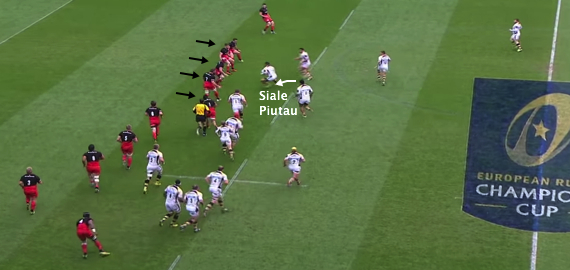
…where he is met by Brits. Now, take note of the time on the clock when the first contact occurs:
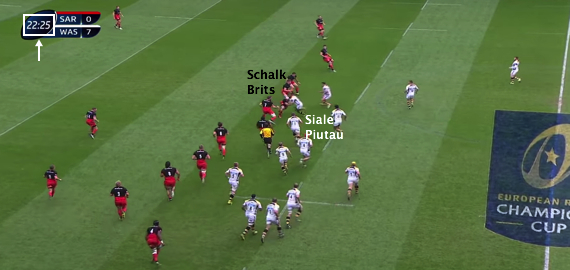
Fraser hits the tackle too, holding Piutau above the ground:
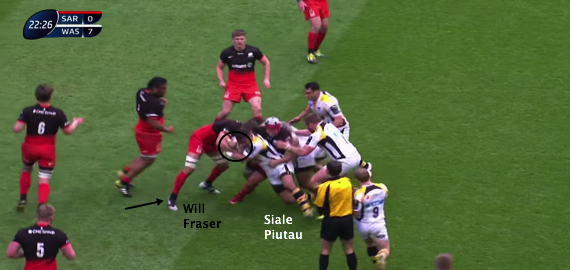
Consequently, with referee Romain Poite confirming the ball has not yet hit the ground and formed a ruck, Wasps cannot recycle.
Five seconds have already elapsed and Saracens can calmly organise their defence for the next phase:
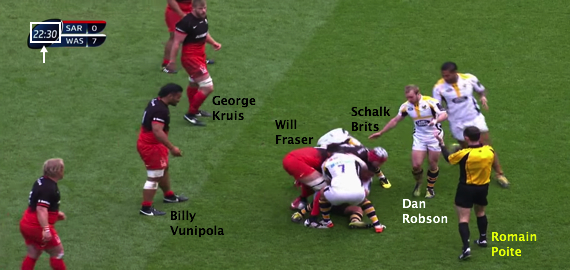
Indeed, by the time Piutau does wrestle to deck and Robson moves it on again, there has been a seven-second pause:

Mako Vunipola speeds up to chop down Festuccia…
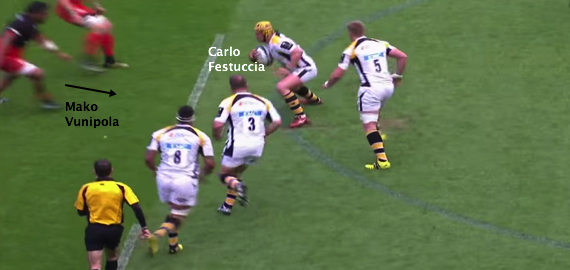
…and Kruis threatens the ball amid the attentions of supporting Bradley Davies:
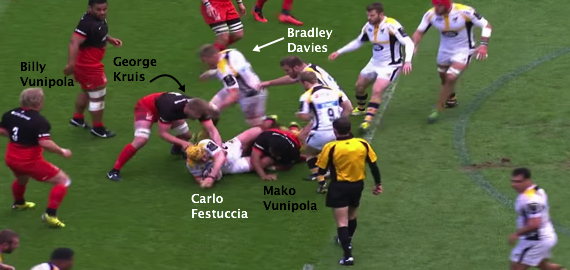
Davies, though, has overrun Festuccia and can only clear Kruis from the side:

Poite awards Saracens a penalty and they can clear:
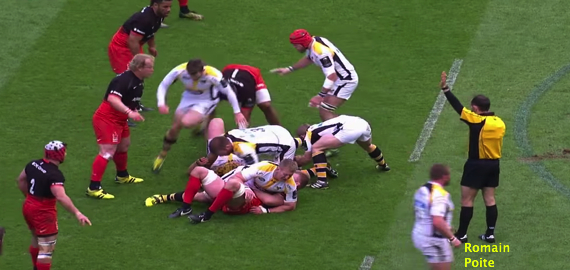
The ‘wolf-pack’ moniker will be used ad nauseam this weekend. The Saracens defence must be at its relentless best, but handling and spontaneous spatial awareness also feature in their armoury.
Piano pushers playing ball
The truism reads that southern hemisphere forwards elevate their teams to another level of fluidity and finishing. Broadly speaking, it is a cliché that holds a lot of weight. That said, the Saracens pack can create as well as dominate.
Think of England‘s most attractive rugby during the Six Nations – Jack Nowell‘s try from Mako Vunipola‘s delicious pull-back pass, the Jamie George offload that sent Farrell under the sticks in Rome.
Wasps saw a fairly innocuous situation become extremely dangerous thanks to a blend of intimidation and innovation from the Saracens forwards. We begin with Robson at the base of a ruck on his own 10-metre line…

…an uncharacteristically poor pass gives Siale Piutau, under pressure from Billy Vunipola and Barritt anyway, very little chance:

With the ball bouncing loose, Itoje and Rhodes charge through…
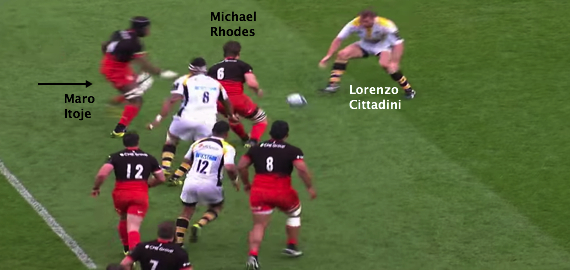
Diving towards the ball, Itoje barges Lorenzo Cittadini out of the way:
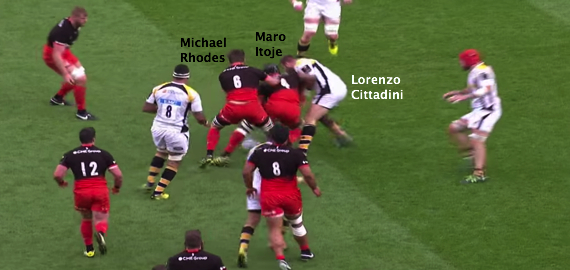
Rhodes stoops and flicks a pass from the floor to Kruis despite the attentions of Hughes…

…and Kruis’ first instinct is to move the ball to a teammate in a better position. This sounds simple, but can be rare among northern hemisphere tight-five forwards. The lock passes to Mako Vunipola…
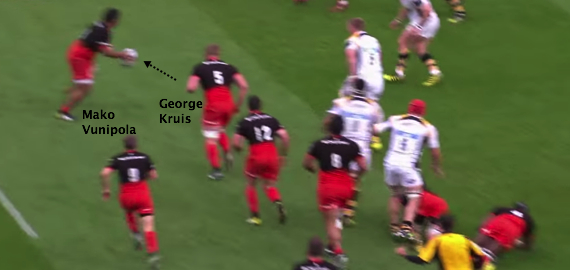
…who throws a gorgeous 15-metre miss-pass to Brits, suddenly opening up vast amounts of space to the left:
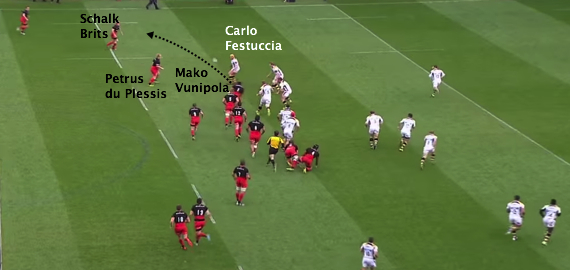
Festuccia does well to recover, but Brits offloads out the back of his left hand to Wyles…

…and Mako Vunipola is back in the game again, calling for an inside pass as Wyles cuts inside:
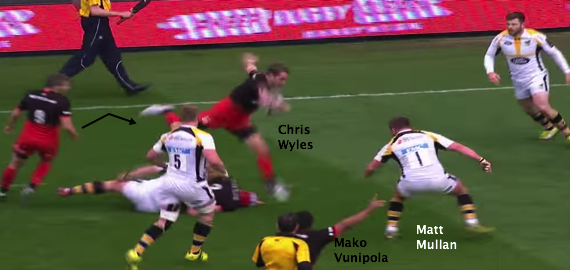
And receiving one:
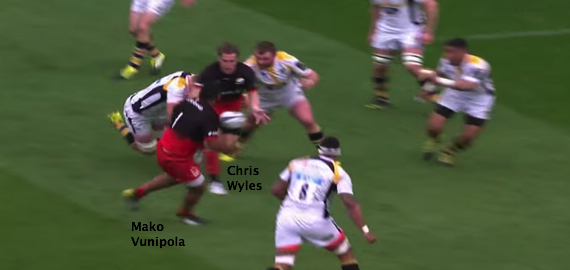
On turnover ball, as defence becomes attack, these little touches in tight play often conjure try-scoring chances.
Conversely, when scrambling to defence after a turnover, work-rate and desire are the most valuable commodities.
Salvaging situations
This section aims to reinforce the value of anticipation and positioning, as well as uncomplicated industry. It starts with Joe Simpson igniting a Wasps attack from deep. He finds Siale Piutau, who is faced with the Saracens press:
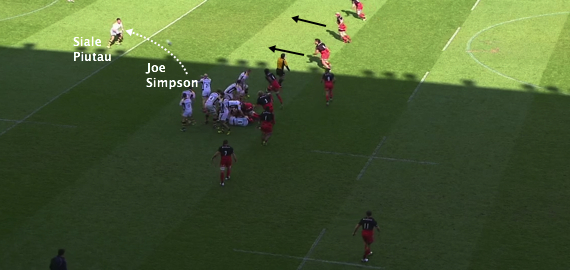
Piutau transfers to his brother Charles, who chips over the onrushing defenders and into space:
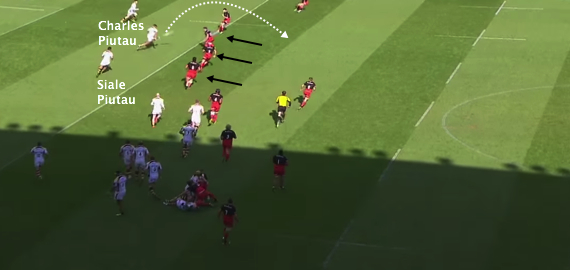
Full-back Alex Goode, in supreme form all season, is across to field the bobbling ball…
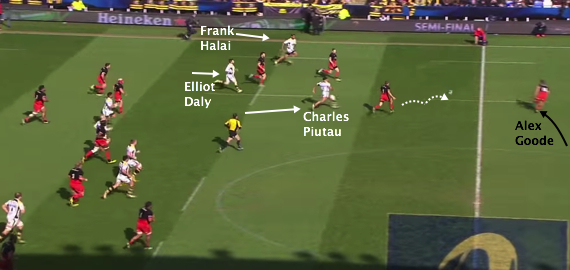
He evades Piutau and Halai…
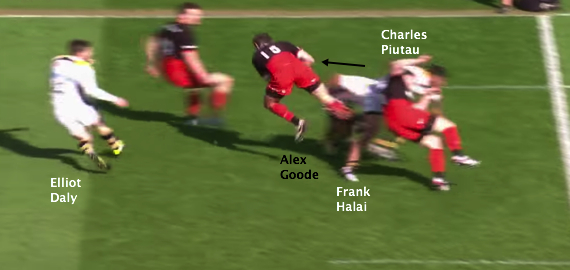
…before fending away Daly as the excellent Duncan Taylor recovers to offer his support:

Goode’s hand-off allows just enough room for him to aim a right-footed grubber down the touchline…
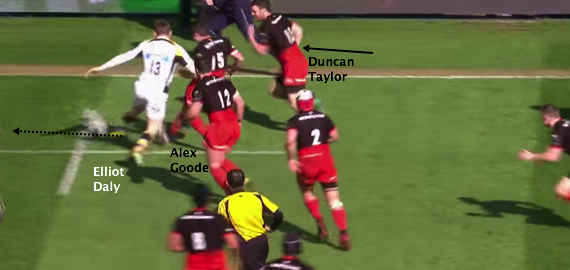
…and Wasps are forced to reconvene at a lineout on their own 22 –a good result for Saracens, who lead 14-10 at this stage.

However, Simpson sends a quick lineout long to Jimmy Gopperth…

…and Gopperth unleashes Christian Wade:
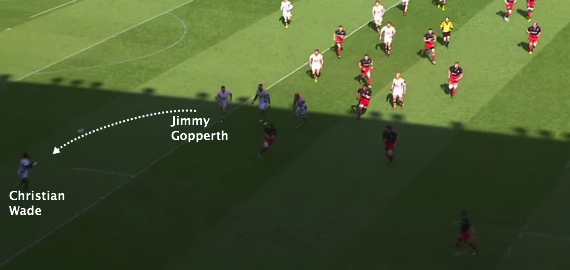
Wade scorches up-field, but the desire of the retreating Saracens is obvious, with Billy Vunipola and Goode the last two men:
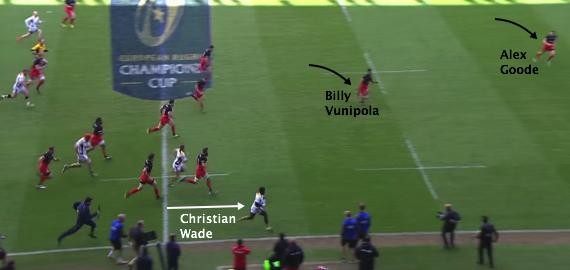
Vunipola is beaten as Wade steps inside, but that slows the Wasps wing enough for Goode to make the tackle:
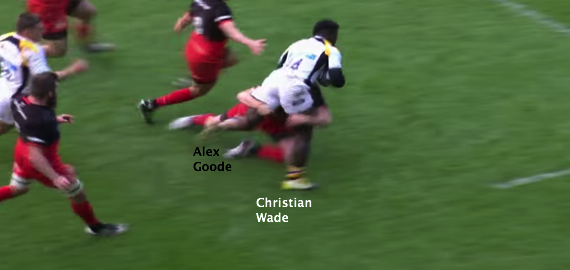
Showing excellent discipline, Rhodes and Barritt get behind the back foot of the ensuing ruck…
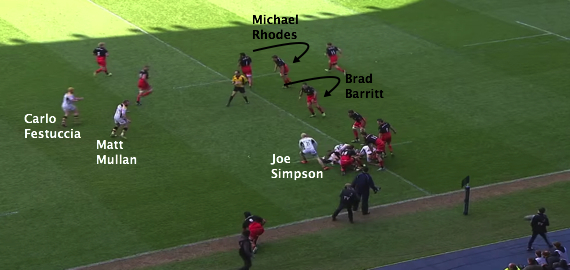
…and then combine to halt Mullan, making it difficult for Wasps to recycle:
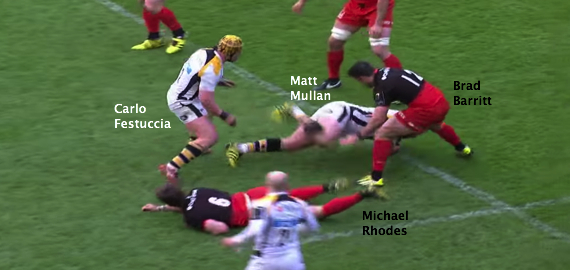
Before finishing with another look at Saracens’ attack, it is worth underlining one more piece of defensive decision-making.
Rushing up and snuffing out
We have already explored the mechanical muscle of the Saracens pack, but their backline also boasts fine defenders. Farrell and Barritt represent obvious examples. Here though, it is Wyles that makes an excellent intervention.
Robson passes to Gopperth as Wasps probe right from a centre-field breakdown. Circled is Fraser, hardly sluggish but still a forward in the outer expanses:
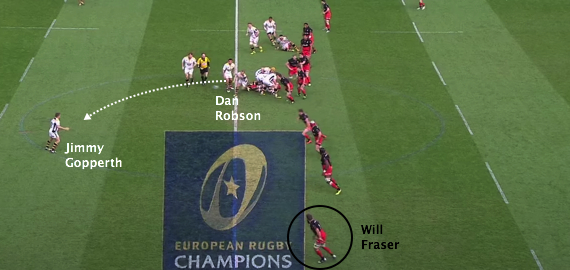
Bypassing Charles Piutau Gopperth hits Daly. Now, Daly’s outside arc has carved teams apart all year and he would certainly back himself to burn Fraser.
But Wyles does not give him a chance. The USA international jams in…
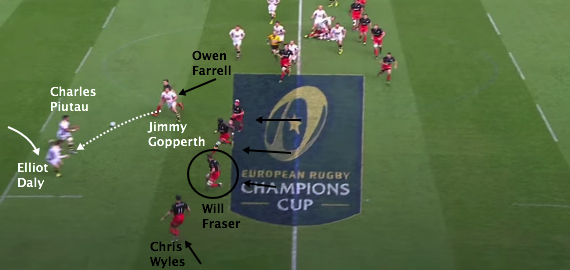
…leaving the hugely dangerous Wade to wrap up the ball:

This is a fine piece of proactive play that stunts a potentially perilous attack. At their best, Saracens are equally coordinated with ball in hand.
Response unit
Professional players will tell you that rigid defensive systems are far easier to master than attacking ones, which rely on mutual understanding and reacting to one another. These days, there is variety and dynamism in the way Saracens go about things.
Take this passage as Robson hoists a high ball. Note that Halai is the only chaser on the right-hand side of the ruck as Wigglesworth retreats:
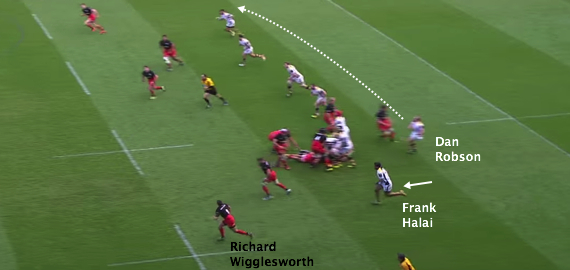
Circling back to support Goode –we will look more closely at how these two combine in the final segment – Ashton looks over his shoulder to see Halai on his own:
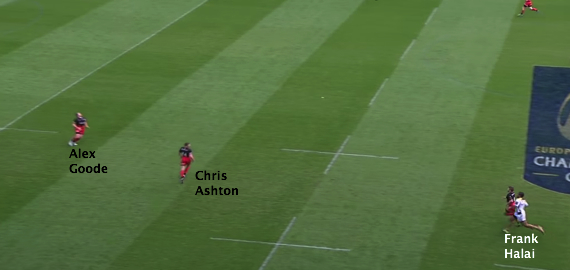
Having assessed the landscape, Ashton curves around Goode’s right shoulder, looking for the space on Halai’s right:

After taking the ball forward a few metres, Goode attempts to draw Halai and release Ashton into this space. By this point, Wigglesworth has worked back to offer his services to the counter as well:
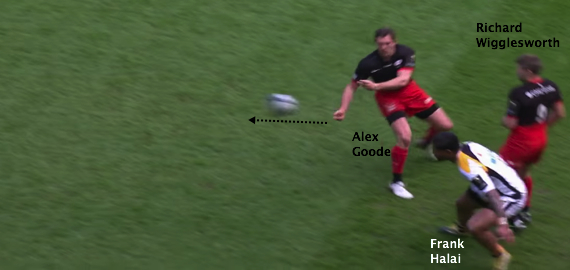
Halai is not sucked in by Goode and tracks across to meet Ashton. However, Ashton knows he has support on the inside and immediately finds Wigglesworth…
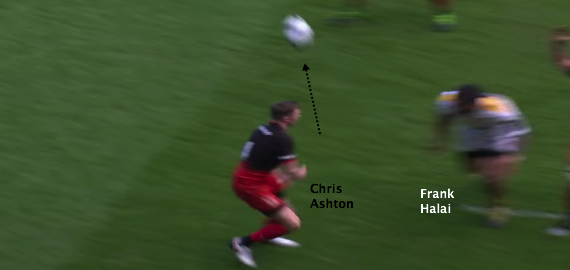
…who transfers to Goode. The full-back is under pressure from three chasers now…
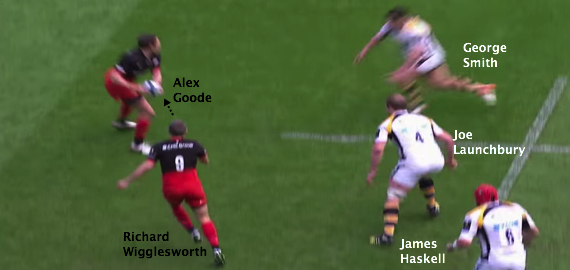
…but evades them all wonderfully…
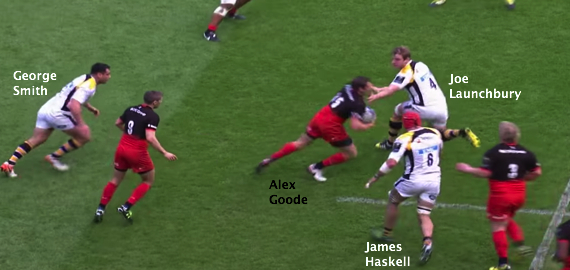
…and Saracens can recycle close to halfway.
Billy Vunipola, comfortable at first receiver, is faced with a defensive line that has one glaring dog-leg. Festuccia is lagging behind his colleagues:
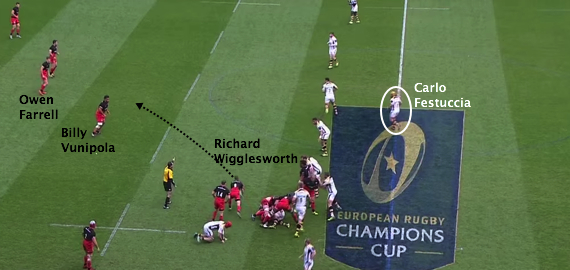
Throwing a dummy, Vunipola straightens up and goes direct:
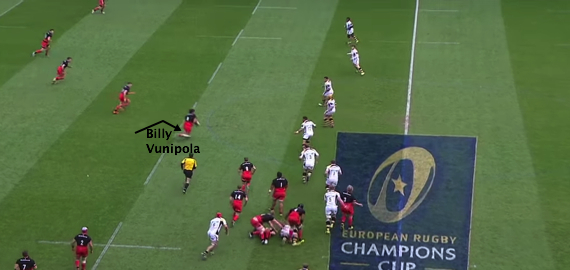
From the reverse angle, we can see the gap that attracts him. Aiming for a space rather than a face, Vunipola is putting more stress on the defence, especially as Farrell mirrors his angle of running:
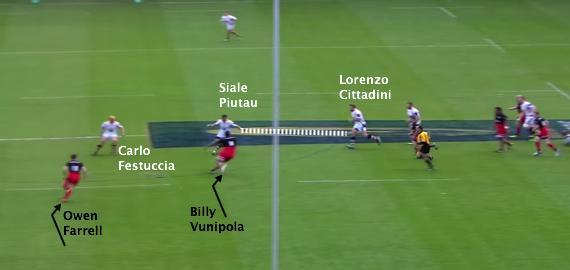
As Vunipola nears the defensive line and attracts two tacklers, Farrell accelerates towards his teammate’s left shoulder…
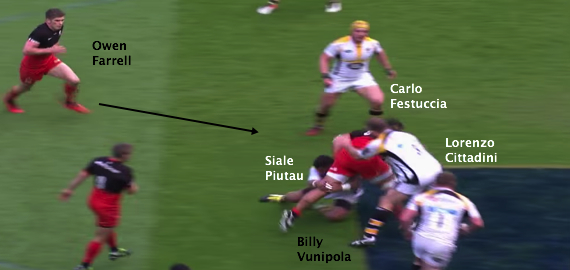
…and is rewarded when Vunipola frees an arm to get the pass away:
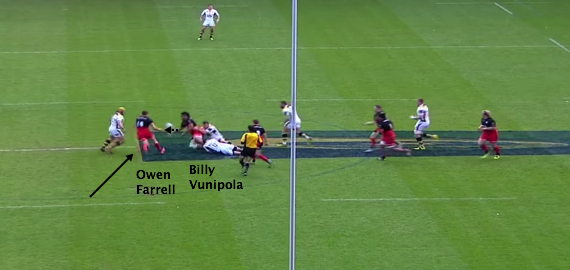
Festuccia just stopped Farrell in this instance, but the fly-half has enhanced his running game markedly in recent times and will no doubt look to take on Racing 92. His snappy distribution in phase-play patterns will be just as crucial.
Vision and incision
As mentioned previously, Saracens were a long way off their best against Northampton in the Champions Cup quarter-final. That said, the try that took them into the lead for the first time – with 68 minutes on the clock – was extremely slick.
Having worked their way deep into the 22 from a dominant scrum, a round-the-corner play sees Kruis and carrier Brits dart from left to right. Itoje is further back but moving in the same direction. Farrell and Goode are options in the second wave and Ashton lurks wider:
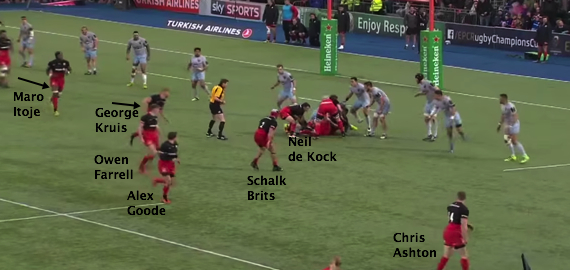
As scrum-half Neil de Kock sends up Brits; Farrell, Goode and Ashton have reached the 15-metre channel close to the right-hand touchline:

Even so, when the try does come in two phases’ time on the opposite side of the field, this circled trio is fundamental in cracking Saints’ defence.
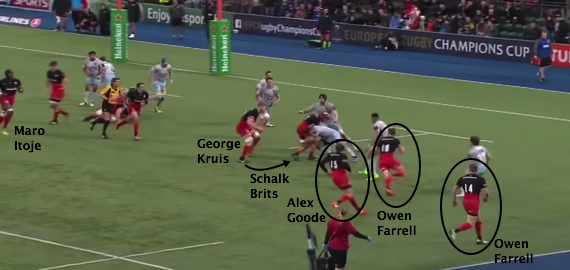
Before that, Brits takes contact, with Kruis and Itoje rucking over:
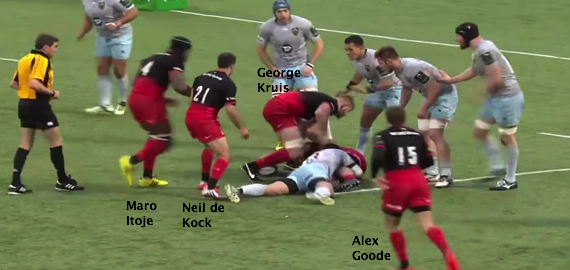
It is here that Saracens bounce back against the grain, de Kock spinning a pass into midfield to find a marauding Mako Vunipola – who, like his brother in the above section, is aiming at a gap:
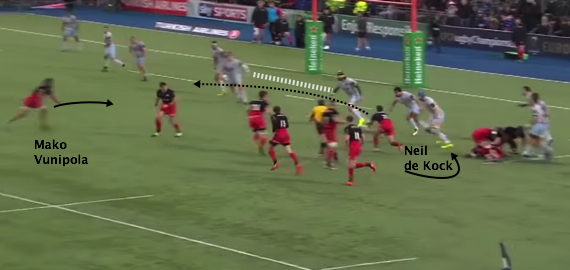
Now there is real momentum. Farrell has made it across to first receiver. Goode and Ashton, both of whom have been the last man standing in yo-yo fitness tests among England backs, are arcing behind their fly-half as Billy Vunipola steams in from the left:

Farrell’s angle of running is copybook here. Rather than drifting on the pass and cutting off the space of his colleagues outside him, he turns his shoulders to the right and circles back towards the ruck. This means Courtney Lawes, one of Northampton’s best tacklers, is fixed:
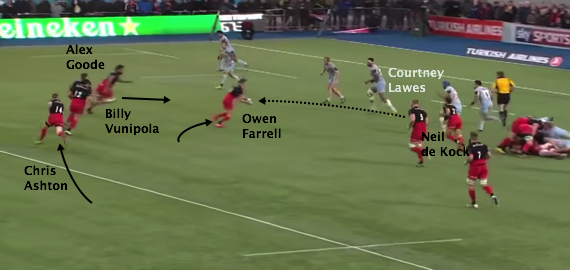
Vunipola’s decoy run is convincing, rendering both Lawes and Mikey Haywood flat-footed in anticipation of a monster collision. But instead, Goode is the recipient of a lovely, drawn back pass:

Saints’ Stephen Myler comes in to take Goode as wing Ken Pisi treads water, wary of both Taylor and Wyles outside of him…
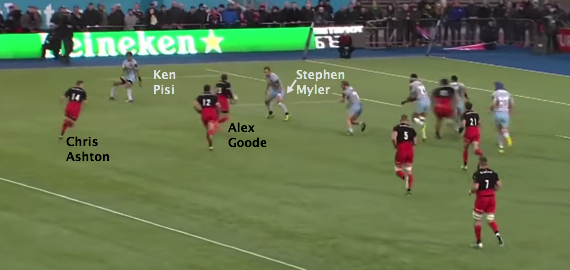
A delayed pop then sends over Ashton, who has expertly sniffed the gap and receives due reward for his off-the-ball graft:

A great many of these elements must click if Saracens are to oust Racing for a maiden European crown. The task is huge and talk of destiny – from outside their camp, it should be stressed – is complacent. But they certainly possess all the right tools to lift this trophy.






